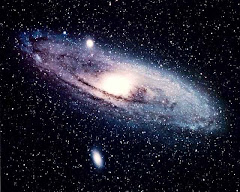 The metric expansion of space is the averaged increase of metric (i.e. measured) distance between objects in the universe with time. It is an intrinsic expansion—that is, it is defined by the relative separation of parts of the universe and not by motion "outward" into preexisting space. Metric expansion is a key feature of Big Bang cosmology and is modeled mathematically with the FLRW metric. This model is valid in the present era only at relatively large scales (roughly the scale of galactic superclusters and above). At smaller scales matter has clumped together under the influence of gravitational attraction and these clumps do not individually expand, though they continue to recede from one another. The expansion is due partly to inertia (that is, the matter in the universe is separating because it was separating in the past) and partly to a repulsive force of unknown nature, which may be a cosmological constant. Inertia dominated the expansion in the early universe, and according to the ΛCDM model the cosmological constant will dominate in the future. In the present era they contribute in roughly equal proportions.
The metric expansion of space is the averaged increase of metric (i.e. measured) distance between objects in the universe with time. It is an intrinsic expansion—that is, it is defined by the relative separation of parts of the universe and not by motion "outward" into preexisting space. Metric expansion is a key feature of Big Bang cosmology and is modeled mathematically with the FLRW metric. This model is valid in the present era only at relatively large scales (roughly the scale of galactic superclusters and above). At smaller scales matter has clumped together under the influence of gravitational attraction and these clumps do not individually expand, though they continue to recede from one another. The expansion is due partly to inertia (that is, the matter in the universe is separating because it was separating in the past) and partly to a repulsive force of unknown nature, which may be a cosmological constant. Inertia dominated the expansion in the early universe, and according to the ΛCDM model the cosmological constant will dominate in the future. In the present era they contribute in roughly equal proportions.
The metric expansion leads naturally to recession speeds which exceed the "speed of light" c and to distances which exceed c times the age of the universe, which is a frequent source of confusion among amateurs and even professional physicists. The speed c has no special significance at cosmological scales.
Monday, November 24, 2008
Metric expansion of space
Subscribe to:
Comments (Atom)











